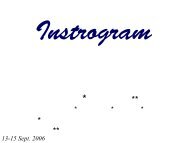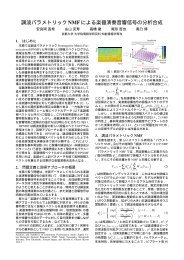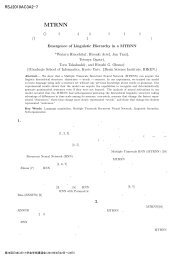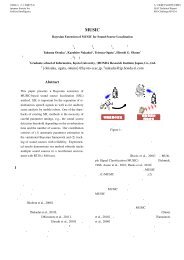第22回 ロボット聴覚特集 - 奥乃研究室 - 京都大学
第22回 ロボット聴覚特集 - 奥乃研究室 - 京都大学
第22回 ロボット聴覚特集 - 奥乃研究室 - 京都大学
Create successful ePaper yourself
Turn your PDF publications into a flip-book with our unique Google optimized e-Paper software.
Class 10degClass 20degClass 10degClass 20degClass 30degClass 30degFigure 7: Data distribution before HLDAFigure 8: Data distribution after HLDAUIEM AM2 usefuldimension 14 UIEM BM 65% HLDA HLDA HLDA HLDA Figure 7 Figure7 17 18 HLDA Figure 8 Figure 8 1 2 HLDA HLDAHLDA 5 HLDA 65% [1] “ 4 ,” SIG-Challenge-0420-4pp.21-27Dec.2004.[2] N.Mochiki, T.Sekiya, T.Ogawa and T.Kobayashi,“Recognition of Three Simultaneous Utteranceof Speech by Four-line Directivity MicrophoneMounted on Head of Robot,” Proc.ICSLP, pp.821-824,2004.[3] “ 4 ,” , pp.821-824, 2005.[4] K.NakadaiD.MatusuraH.G.OkunoH.Kitano,“Applying Scattering Theory to Robot AuditionSystem,” Proc.IROS, pp.1147-1152, Oct.2003.[5] N.Kumar, “Investigation of silicon-auditory modelsand generalizationof linear discriminant analysis forimproved speech recognition,” Ph.D. dissertation,Johns Hopkins Univ., Baltimore, MD, 1997.[6] M.J.Hunt and C.Lefebre, “A comparison of severalacoustic representations for speech recognition withdegraded and undegraded speech,” Proc.ICASSP,pp.262-265, 1989.[7] P.Brown, “The acoustic-modeling problem in automaticspeech recognition,” Ph.D. dissertation, IBM93
















